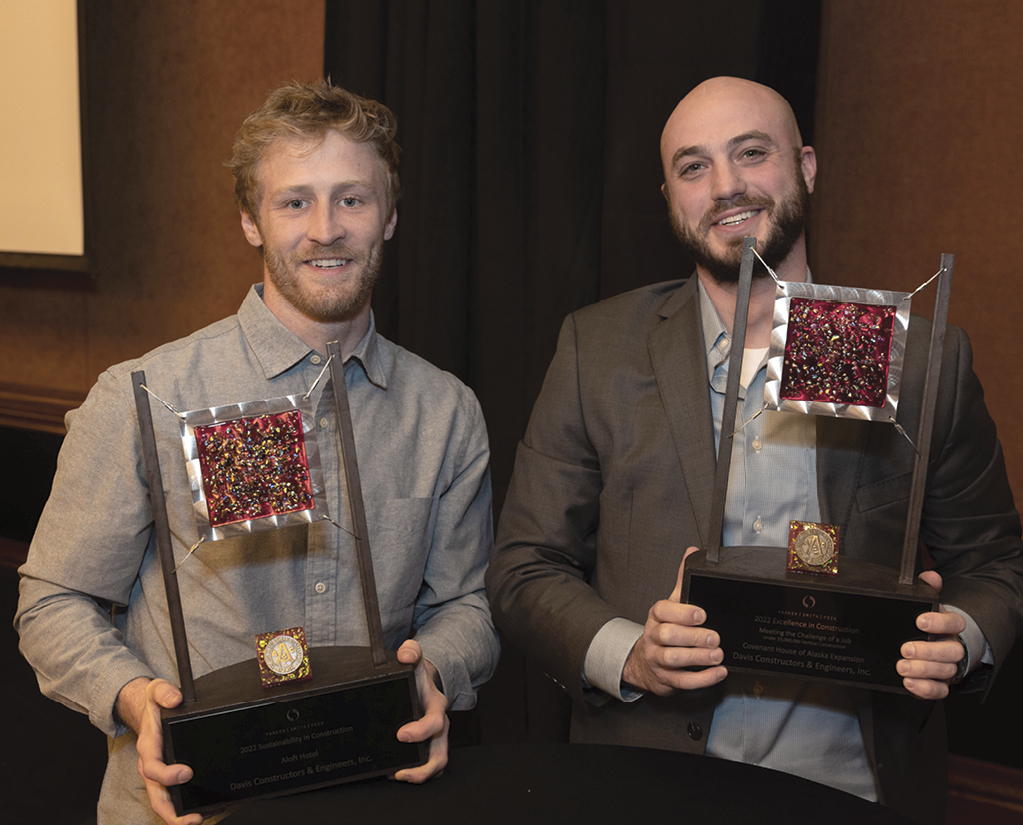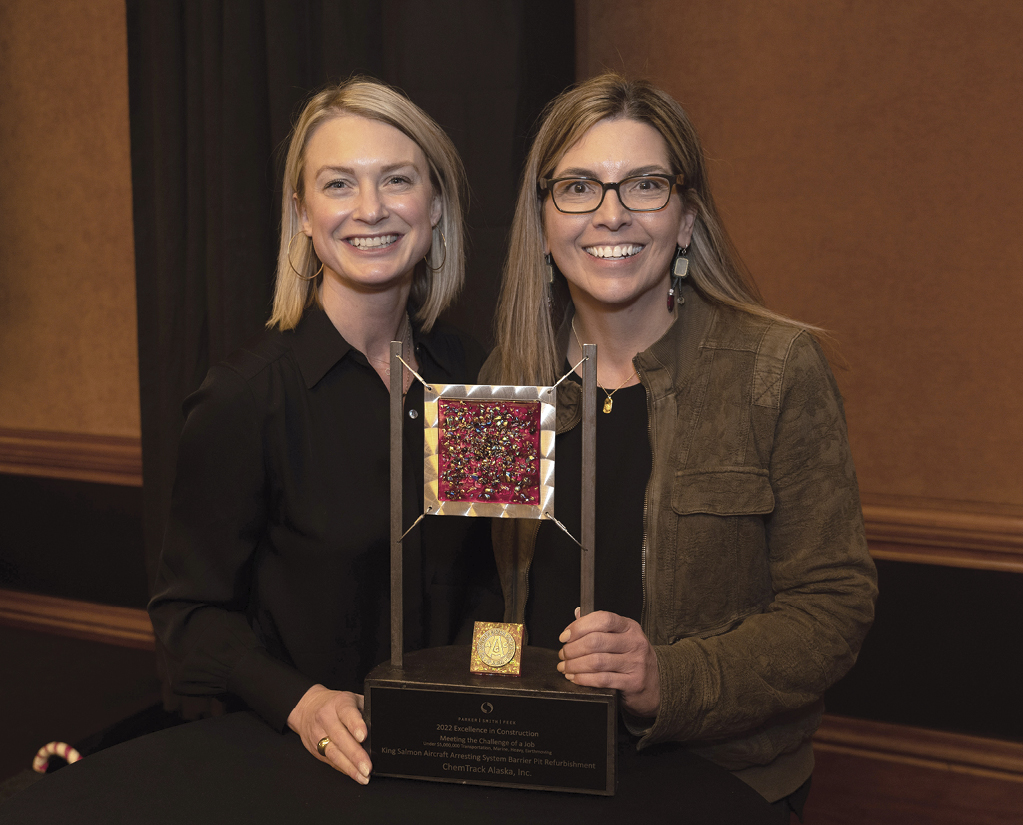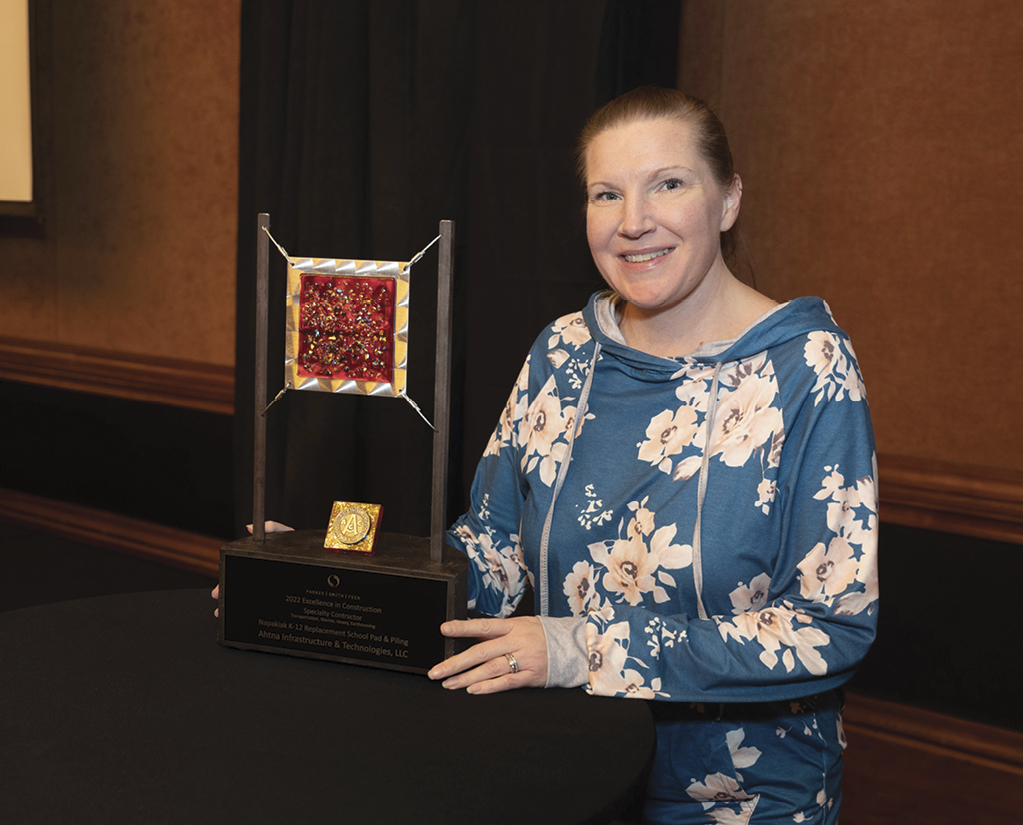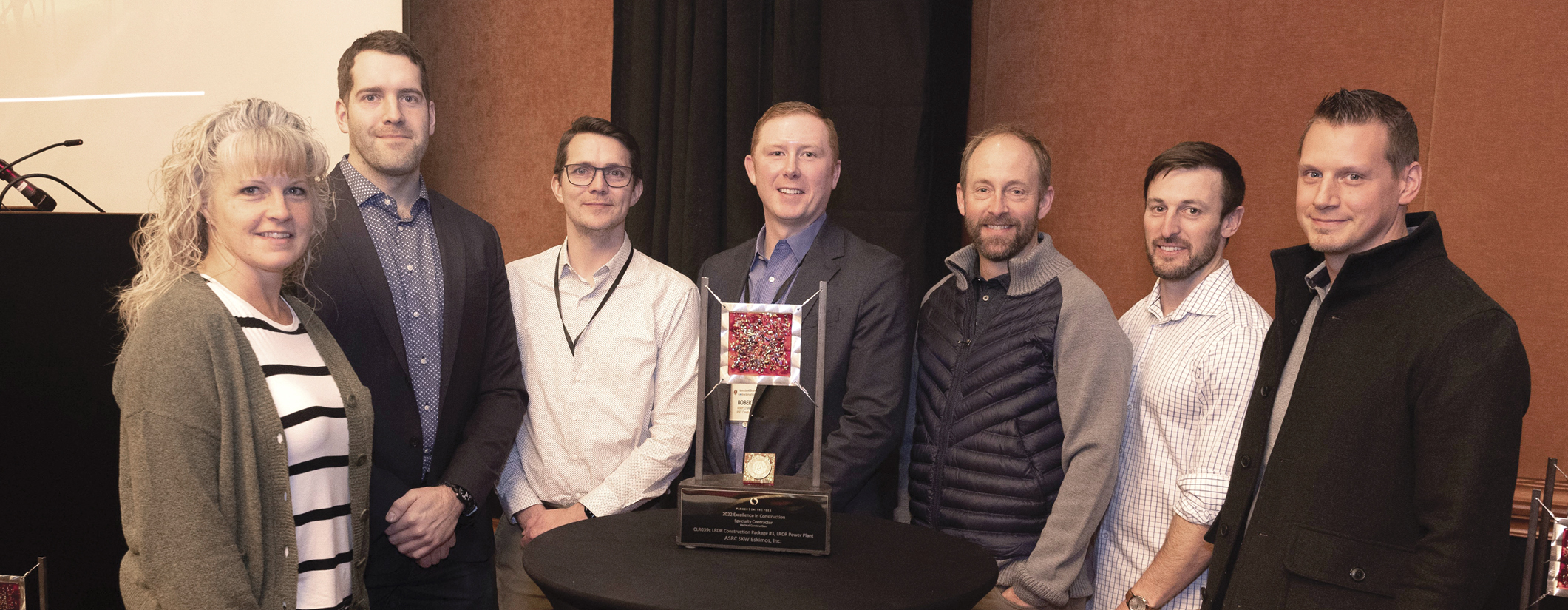


nnovation, meeting challenges with unique resilience, and building community good will for projects were some of the strengths that helped the 2022 Excellence in Construction award winners achieve recognition. Awards were presented at the Parker, Smith & Feek Excellence in Construction awards luncheon on November 11 during the the Associated General Contractors of Alaska Annual Convention.
The project was a bit of a tight squeeze: the new, three-story, 10,000-square-foot building was built in a 10,500-square-foot space located in Downtown Anchorage. Working Downtown meant performing extensive pedestrian and vehicle traffic control for material deliveries and day-to-day work. The building includes some interesting features, such as a modified exterior rain screen system and highly efficient solar panels. Perhaps the largest challenge, however, was squeezing as much of what Covenant House hoped for out of a limited project budget.
“Our project team spent countless hours redesigning the expansion project and provided extensive Life Cycle Cost Analysis work sessions to bring the project to reality,” Davis leaders stated in the application.
While the success of the project is its own reward, Davis Project Manager Matthew Helzer says it’s an honor to be recognized by AGC of Alaska.
“Receiving this award benefits Davis by reminding us that great things come from small beginnings. It is not always the biggest projects that can have the largest impacts to our community,” says Helzer.
The project included innovative techniques and materials, used with style and attention to detail. The Navigator’s Lounge includes acoustic drop ceiling panels to reduce noise. A transparent felt ceiling in the lounge also helps to dampen sound. A cascade coil ceiling drape—so large and heavy it required the entire project team to help handle and install it—is made with abacus beads to engage guests and encourage them to interact with the art. Recycled materials were used where possible, from environmentally friendly flooring to wall partitions made from recycled materials.
Ultimately, though, Pearl-Grace Pantaleone, business development and marketing manager for Cornerstone General Contractors, Inc., says the project is notable because it breathes new life into the Ted Stevens Anchorage International Airport’s North Terminal.
Cornerstone has been on the winner’s list for excellence in construction each year for decades. Pantaleone says it’s due, in part, to a commitment to top-level work: “We like to continue the reputation of building excellent projects in Alaska and our community.”


Innovative uses of technology in this project include completing a laser imaging, detection, and ranging, or LiDAR, survey of the building to create a precise 3D model of the building showing every structural element and bolt in the hangar wing. This process allowed the engineering team to evaluate the building frame and determine an efficient and cost-effective structural upgrade.
One of the more striking elements of the project was the level of communication required to make it a success.
“This project began at the onset of a global pandemic. Protocols were ever changing; procedures were being reformed; supply chains were halting; and new technology was being introduced. From the beginning, UNIT was able to establish an environment of effective and open communication from the office to the jobsite. From the US Air Force, USACE, and design team to the subcontractors and suppliers, we were always able to clearly express and understand one another’s thoughts and opinions, respectfully disagree, clarify, discuss, and be mindful of each other’s needs. There was always a consistent feeling, that through hard work, we could create a successful project and deliver it on time and within budget, regardless of challenges faced,” UNIT COMPANY leaders wrote in their award submission.
Trent Larson with UNIT COMPANY says the recognition of excellence from AGC and Parker, Smith & Feek underscores that cooperative feeling.
“Overall it reinforces the relationships built with subcontractors, designers, and users of the facility of the project. It gives the feeling that we as a group accomplished something great and will more likely be willing to work together again,” Larson says.


The protective measure, called an Aircraft Arresting System, or AAS, saves lives and prevents costly airplane damage by preventing aircraft from overrunning runways if the pilot is unable to stop on landing or a takeoff is aborted.
The King Salmon airport, busy every summer with traffic from tourists viewing bears and fishermen heading to Bristol Bay, was home to an air navigation silo in the ‘30s. In World War II, the US Army built an air base around the silo. Although the base closed in 1993, other government agencies sprang up around the area that are still operating. Although there are several types of aircraft arresting systems, the one at the King Salmon airport is a cable system typically used by the military for tactical aircraft. Arresting cables span the runway surface and, once activated, are engaged by the aircraft arresting gear hook.
The aircraft arresting system works in conjunction with two barrier pits, which also needed to be refurbished. The arresting cables and pits were offline since 2017 in preparation for runway repairs that happened between 2018 and 2019. They needed to be replaced. The trick, however, was refurbishing the barrier pits and having everything ready to install the new cables as quickly as possible—all without disrupting air traffic at the busy airport. Getting ready meant cooperating with the various project stakeholders to obtain security badges, dig permits, general work scheduling, and more.
Most of the work had to be done at night. The barrier pits that house the cables that engage the aircraft were readied first, then the team prepared for the final site construction sequence, a planned 65-hour closure.
“ChemTrack worked simultaneously at both ends of the runway to sawcut asphalt, augur and remove soil, install rebar cages, place concrete, install hold down bolts, hand trowel to 1/8 inch below grade, and cover with blankets for curing. ChemTrack pre-planned to install the hold downs at the center-runway four locations first and the outer locations last. If there was a delay or difficulty encountered in the initial process, this work sequence would allow air traffic to proceed along the center of the airstrip. Despite the many project challenges and limited work area, ChemTrack safely refurbished the King Salmon AAS without impeding the busy air traffic of this regional hub and fishing mecca,” ChemTrack officials wrote in the award submission.
The work went off without a hitch, which is just what they prepared for.
“ChemTrack continually finishes projects both on-time and on-budget while also receiving EXCEPTIONAL reviews from contracting officers via the CPARs [Contractor Performance Assessment Reporting] system. We are able to receive these high marks and provide excellence in performance due to our employees. Awards, like the AGC Excellence in Construction format, provide recognition and kudos for our team,” says Jenith Ziegler, vice president for ChemTrack Alaska.
QAP repaired a significant depression at the Kotzebue Airport Runway 9/27 that was limiting air traffic.
“QAP planned, prepared, and executed work diligently to deliver the project roughly one month ahead of the contract completion, despite barges charged with delivering project aggregate to the jobsite arriving three weeks behind schedule due to inclement weather in the Chukchi Sea. A subsequent severe ‘fifty-year’ storm decimated many coastal communities dotting the shores of Western Alaska in mid-September, causing extreme flooding, at an extremely inopportune time, preceding paving. While water receded, QAP proceeded, completing work despite all challenges,” QAP officials wrote in their submittal.
The project succeeded despite the challenges because QAP builds relationships in the communities in which it works.
“To achieve Excellence in Construction, one must first achieve excellence in people, communication. and relationships. We are all in the people business and the relationships built in Western Alaska are hearty,” QAP officials wrote in their award submittal. “Work within Western Alaska at QAP is performed by a small, tight-knit group of personnel willing and able to tackle the challenges that arise working in Western Alaska.”
Pairing with other companies working in the area, QAP created partnerships that allowed it to successfully complete the project. The company brought in a conveyor to speed the loading/offloading process for aggregates, and Cruz Construction, Inc., also working in the area, provided a loader to feed the conveyor.
“Sharing these resources allowed us to save time, cost, and valuable deck space needed to stack aggregates and reduce barging durations,” QAP officials wrote in the application. “To complete this project in a very brief window of time (mid-July to September), we needed every person involved to be engaged, communicate effectively, and adapt to changing circumstances.”
Scott Link, QAP superintendent, says receiving the Excellence in Construction award is meaningful to him and to the whole QAP team.
“Milestones such as AGC’s Excellence in Construction allow us to take stock of what we have done well and share this accomplishment with our employees, subcontractors, vendors, owners, and the entire team it takes to safely perform work in the challenging environment of Western Alaska. Often in the construction industry we are focused on accomplishing the next task, and the overall project, so these moments in the spotlight allow us to appreciate a job well done and share the happy news of the recognition received with all of the people who aided in the building of the work. QAP would like to thank AGC for the time and effort to plan, organize, and execute the Excellence in Construction awards; this annual event is a foundational piece that helps the entire community celebrate successes and gather to socialize and connect with others based on our shared experience,” Link says.


Ahtna’s project manager, Kevin Perry, grew up in Bethel, fourteen miles from Napakiak. With a strong connection to the area, Perry helped build infrastructure to better the community: In addition to its contracted work, Ahtna repurposed excavated material by using it to build five foundation pads throughout Bethel at no cost to the city or school district.
Ultimately, the pad for the new school is about much more than just a building. It’s part of a community re-building effort.
“The school is the village’s largest building and a hub for the community—they host everything from basketball games to funerals in this central location. When spring floods occur, when the frozen river would thaw faster than it could drain, residents would gather in the school’s gym. Although Ahtna was hired by the school district, the team understood that this project benefited everyone in the community and that maintaining the completion schedule was our top priority. Ahtna continually coordinated with the Napakiak Corporation and the City of Napakiak for housing, equipment rental, and local laborers, which brought needed revenue to the residents of this remote community,” Ahtna officials wrote in the award submittal.
The LRDR is a key component of US missile defenses. However, the LRDR cannot function without power, and ASKW built the power plant to provide backup power to mission and non-mission loads in case the main power plant is disrupted.
“Early collaboration with the US Army Corps of Engineers, Missile Defense Agency, and key specialty subcontractors and suppliers allowed us to meet the accelerated schedule,” ASKW officials wrote in their award submittal. “This was the first project designed and constructed to meet stringent Mission Critical 1, Risk Category 5 seismic requirements.”
Building a power plant to meet those standards was difficult, says Robert Champion, ASRC Construction’s president and CEO.
“Everything about the LRDR program is notably challenging. In particular to the power plant, the risk category V seismic requirements and HEMP (High Altitude Electromagnetic Pulse) shielding were uniquely challenging scopes of work,” Champion says.
But the basics, like carefully understanding what the client needs, is universal for ASRC projects.
Champion says he and his team are thankful for the recognition of a job well done.
“It is an honor to be recognized as an industry leader in construction excellence. The award is a direct result of our team’s ability to partner with the client. Successful projects like the LRDR power plant allow us to bid on a variety of USACE projects,” Champion says.

Davis Constructors & Engineers, Inc., built the 83,136-square-foot hotel, pausing for a COVID-19 furlough midway through the process. Some of the more notable aspects of the project included installation of four electrical vehicle charging stations, which allow multiple efficient charging options on site. The company also incorporated a Capstone 65 microturbine to lower electrical costs, as it generates its own electricity using natural gas.
“This especially makes sense somewhere like Alaska where the major utility companies employ natural gas to generate electric power, meaning Aloft Hotel is able to directly convert the natural gas to electricity onsite serving the [fire, life, safety] systems, in turn enabling cost savings to the owner by reducing the peak demand at the hotel. To maximize building efficiency further, the pool temperature controls are controlled using the waste heat to supplement the hydronic system heat in the building,” Davis officials wrote in the award submittal.
The 146-room hotel opened in May 2022 and was fully booked the whole summer, Davis officials say.
Working on one of the most modern and technologically advanced hotels in the state was enjoyable, says Gaute Johansen, Davis’s project manager.
“Davis enjoys working on challenging projects that also benefit our community. This project brought challenges to our team, which they handled exceptionally well. Including EV charging stations and a microturbine in a new contemporary hotel is something our team will be proud of for years to come. We are excited and proud that Team Davis was recognized for an excellent job constructing the Aloft Hotel,” Johansen says.